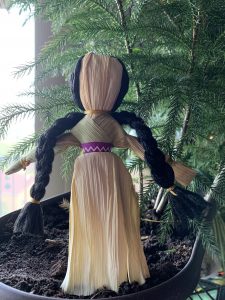The Importance of Storytelling and Oral Tradition
The Importance of Storytelling and Oral Tradition
Topic 2 – The Importance of Storytelling and Oral Tradition
“As the young asked, the old men and the old women thought about these matters. They gave their answers and explanations in the form of stories, songs, prayers, rituals and ceremonies.”
– Basil Johnston, 1976
Stories are used as both primary and supplemental instructional materials. They can also offer experiential knowledge. Accompanying stories with a hands-on activity approach models a traditional way of teaching used in many Native cultures.
Traditional Ojibway Elders often portrayed lessons and expected behaviour told through stories in lodges during times such as times when fishing nets were being repaired, hunting equipment mended, and when clothing and food were being prepared. Characters in the stories, including animals or other creatures in the natural world, often possessed spirits and needed to be passed along with accuracy, respect and sometimes permission to reshare with others. Listeners are often expected to come to their own interpretations, which would help position themselves to their own circumstances rather than views being imposed.
Stories are a pedagogical tool whereby meaning can be expressed, renegotiated, interpreted or shared. It is important to know the context, nation or peoples represented, and any restrictions or recommendations on whether to share the story or not. It is wise to speak with members of the community or the Elders represented to know for sure (Archibald, J., n.d.). JoAnne Archibald also suggests seven principles of Indigenous story work including “respect, responsibility, reverence, reciprocity, inter-relatedness, holism, and synergy”.

An example of a story that might be told is about the Corn Husk doll. It is said that the doll was made from the corn husks as part of the three sisters (corn, beans, and squash) recognition and that given such an honour she wanted to share her status with the children. She began admiring herself and her beauty too much in the reflections on the rivers and the lakes, which took her focus off of providing for the children and neglecting them. Therefore, the Creator summoned her and took the face off of the corn husk doll. This was done to remind us all that vanity can prevent us from accomplishing our tasks and to avoid becoming superficial with others (Hill, R. & Sky, R., 2012). This story is found in its entirety at Hodinohso:ni Art Lesson #9 – Corn Husk Dolls.
Other important stories are the creation stories by each nation. Below are some links to various creation stories:
We have tried to model elements of storytelling throughout this module. We encourage you to research and learn more about Indigenous Peoples stories from the nations you wish to refer to and how you can (or can’t) use them in your teaching practices.
Activity 1: Self-Reflection
- Consider reading a children’s book out loud to learn how to practice emphasizing points, and locating topics that can be repeated, but in a different manner. Stories are often told repeatedly so new nuances are learned or emphasized each time the story is told or listened to.
- Locate a creation story from both the Anishinaabeg and the Haudenoshaunee. Read them to compare and contrast themes and expressions.
References:
Archibald, J., (n.d.). On becoming story ready. Indigenous Storywork. Retrieved Dec 18, 2021 from https://indigenousstorywork.com/1-for-educators/
Hill, R. & Sky, R., (2012) Deyohahá:ge: Indigenous Knowledge Centre Hodinohso:ni Art Lesson #9 – Corn Husk Dolls. https://snpolytechnic.com/sites/default/files/docs/resource/9_haudenosaunee_arts_dolls.pdf
Johnston, B. (1976). Ojibway heritage: The ceremonies, rituals, songs, dances, prayers and legends of the Ojibway. Toronto, ON, Canada: McClelland & Stewart Inc.

